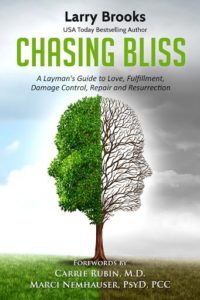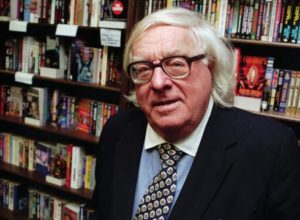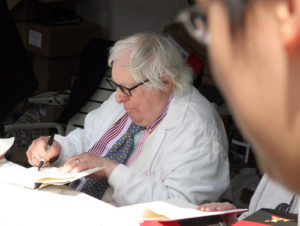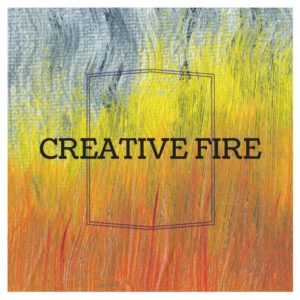By Larry Brooks
Sometimes at night, lying wide-eyed in a bed of regret, I imagine a headline that reads like this:
Former Mid-List Hack Succumbs to Anxiety During Self-Publishing Push, is Hospitalized and Delusional.
Even that much publicity really is a delusion in the self-publishing realm. And the hospital part, that’s just fiction. But the PTSD is real. Sort of.
It all started with this crazy idea to write a book that matters.
I know, completely nuts, right? I’m just a writing guru-type wannabe tugging at Jim Bell’s coattails, a novelist with six mainstream-published (and republished) books nobody in my audience has ever heard of… who am I to think I can write a non-fiction book about love and relationships that will make a difference to anybody?
Right away I knew what was wrong with that plan. I don’t have Ph.D. behind my name on the cover. Publishers love Ph.Ds. I would be writing from the school of hard knocks about lessons learned and the scars to show for it.
Not a memoir though. This would be a bona fide how-to, one that breaks down the relationship proposition into its component parts in much the same way I’ve done in my three writing books.
That’s when it came to me, the moment of no return: I’d do it anyway. I’d self-publish it, just like what everyone else out there seems to be doing. And—this is being the strategic cherry on top—l’d find a credentialed doctor-type to write the foreword and put their name and MD/PhD on the cover with mine.
I found two, actually. And while I thought the book was pretty good, as did my wife (a pretty important endorsement considering the topic), it was when those two professionals confirmed my suspicion (that it is good, and that it matters) that I actually began to visualize something big.
Big plans, big dreams, big ambitions. Just like every other ex-midlist author who takes the leap into the self-publishing darkness.
Writing the book was rewarding. And easy when compared to the steeple-chase obstacle course of actually getting it self-published.
That’s when the crazy began.
Two things reared their heads immediately. I’m not all that technically-savvy, and my proofreading skills sort of suck. Both would haunt me through this process.
The plan was: hire an editor, then a proofreader. Because that’s what I’d read, and it made sense.
Of course I ignored that. I rationalized that a non-fiction book wouldn’t require outside editing (because I am, in my day job, an editor of sorts) beyond what would be obvious to my eagle-eyed wife (the queen of cutting), and that she and I could do the proofing (she’d proven herself in this realm), thus saving about 500 bucks along the way.
And then it all went South.
A writer friend offered to proof the manuscript as a favor. Wouldn’t take my money. Meanwhile, both my wife and I would undertake multiple proofing passes (her list of notes was well in excess of 100 recommendations for cuts, changes and corrections), including submitting the thing to Grammarly, which is an app that bolts onto MS Word and promises to find anything an editor might identify as “iffy.” For free.
Grammarly found 1,244 “issues” among the 288 pages of the manuscript.
That’s when the anxiety really kicked in.
Meanwhile, my proofreading friend got back to me, after investing much time and energy into the project. I opened the file… nothing was there beyond the words themselves. No red ink. No notes. From that I assumed she’d actually changed the manuscript, fixing typos and doing little edits, all of which would remain invisible (and thus, useless, a waste of her time) unless I did a line-by-line comparison. Which meant, I would have nothing to compare to the editing my wife and I were doing.
After a few days of squirming, working through those Grammarly catches (among those 1,244 “issues” were less than 50 actual typos and about a dozen questionable wording choices—if, that is, you are a middle-grade English teacher—leaving 984 “issues” that escaped me, things like “potential misuse of dangling participle” or some such nonsense.
I never really listened to my English teacher about that stuff, and I wasn’t about to go there now. Grammarly… out.
When I worked up the courage to ask my friend where the edits were, she told me (with much patience) that they were in Track Changes. Which I’d heard of. Which I’d actually used during the editing process with Writer’s Digest Books on myhree writing books.
Thing is, though, those manuscripts had arrived with Track Changes already open.
And on this manuscript, on my new computer with its new Windows 10 operating system and its brand new MS Word 8.1, which I’d never seen before and looked to me like a page from Pravda, there was no obvious way to find and open Track Changes.
Google didn’t help.
Oh, it was there, all right. I just couldn’t find it. And thus, couldn’t access her edits and comments. Which were plentiful and astute. When I finally did find it (with her help after my humiliating confession), and after I’d implemented all sorts of edits from Grammarly, my wife and from my own proofing, thus began another pass to cross-check and implement from those four different sources.
All this took about two insane weeks, neither of which I’d planned for. My day job as a story coach went on hold and my clients were getting impatient, I was eating like crap and couldn’t sleep… my God, this was a wonderful experience so far.
During this time I had been going back and forth with the cover designer, after purchasing a generic version that was really killer. You wouldn’t think adding titles and my name and the back copy would be that hard. It wasn’t, actually, but then came the next curve ball.
Createspace needs to know the exact interior page count to calibrate the width of the spine. Actually, the designer needs to know that first. It’s a different number than the manuscript pages, this is the actual number of book pages. So with my book in about five simultaneous stages of revision, the cover had to sit on hold until I finally received the first proof copy of the paperback from Createspace.
Which was several unexpected hurdles away, consuming about two more unplanned weeks.
When you finish writing a book you are impatient to get it out there. Brevity of release ramp up is one the attractions of self-publishing (versus the full year or more a publisher will make you wait), so I was itchy to get this up and running. With all those typos and fixes in place, I could smell the finish line.
This was the raw grist, the sum and total, of the emotions that were making me crazy.
Upon finishing what I thought was the final draft of the manuscript of CHASING BLISS, I went to the Amazon author site, set up the book and submitted it to their online formatting tool. It looked like a bored cat had been playing with the space bar, separating paragraphs and inserting inexplicable white space everywhere. Of course that was my fault, using the wrong keys in the wrong way, imparting secret coded messages to the formatting gods… because that’s what writers do, we use the keys on the keyboard.
Couldn’t get it to work. I had been told I could skip paying a formatter and do it myself, correcting these issues myself and resubmitting until I got it right. Maybe. But I couldn’t see that finish line.
And so, following trusted advice (which I should have done earlier), I found a formatter on Fiverr.
Eighty bucks for three versions: Kindle/mobi, Smashwords/epub (which covers bookstores and iBooks), and a locked-down PDF for the paperback inside the Createspace template. It took five days to get the mobi back from my Fiverr guy, with a note (from a land far, far away) to “please check manuscript.”
Right. Got it. Did that, with the same Amazon previewer. Resulting in the same chaotic lack of symmetry spiced with random acts of white space. It was as if the formatter hadn’t even touched it.
Sent it back to him. A day later he said it was fine. Try it again.
Same outcome. Pass the Tums.
Another day later he asked what previewer I was using to do these checks,, as if there was a choice among previewers. Turns out there was. He sent a link to another stand-alone previewer, a deluxe version, which allowed me to see an accurate visual layout in all three formatted editions. Which, when downloaded there, looked beautiful and perfect to my anxious eyes.
I downloaded the mobi to Amazon and hit the Publish button within five minutes. Five more minutes it was in the Smashwords system.
Next day I anxiously bought the first copy of the Kindle. Started reading. Found three typos in the first one hundred pages.
Now, you would think you could just open the mysterious “mobi” file (or the ePub file, which is different) and simply correct the typo, right? But no, that’s too easy. So I googled how to do this, and I ended up with a video by Hugh Howey, who is the king of all things self-publishing and way smarter than me. He explained that you had to download two other pieces of mysterious software, neither of which was “mobi,” open it in one, then open it the other and somehow magically merge those files, and then you can make the changes, and then convert it all back to mobi. Somehow.
Somehow.
Easy right? Yes, if you went to M.I.T. The narration of this process sounded like a Boeing engineer explaining flap resistance coefficients to an FAA inspector.
Wasn’t gonna happen.
So I went back to the format guy who was out there somewhere to ask if he could do these corrections. Two days later, a simple, “yes, tell me corrections.”
Did that. Two more days later, I get the files back. Good to go, all three typos fixed. I checked them on his magic previewer, and it looked… wonderful.
Back to Kindle. I downloaded the updated version, which they would swap out for the one already published in twelve hours. Meanwhile, I logged on at Createspace, opened an account (not as hard as I anticipated), and downloaded the formatted manuscript.
Surprise: they needed to send me a proof copy (which I had to pay for) for my approval, before the actual publishing process could begin. That would take three to five days. This was like being in labor (I imagine), and the doctor telling you not to push for three to five days until they can get you into an empty O.R.
The proof/ARC finally came. It was like opening a Christmas present. The cover was beautiful. Hope returned in a rush of anticipation.
I began to read. My heart sank. I am embarrassed to confess what I found. But I will, because that’s why we’re here. Piece by piece, my brain shattered into 95 little pieces. Because…
Ninety-five more changes were required.
I sh*t you not. Not all of them typos, but awkward moments in the narrative, missing punctuation, and little opportunities for upgrades. It was as if the process had gone back in time and deleted everyone who had set eyes on the thing.
Back to the formatter dude. Offering him more money to get me out of this mess. Another 80 bucks–he sort of had me– which I happily coughed up. I compiled a summary of the changes, with very explicit (I thought) instructions on what was to be changed, and how.
Got a message that it would take 8 to 10 days. By now I would miss my target release date by about a month (good thing nobody was on the edge of their seat out there). All because I didn’t hire a professional proofer, and couldn’t find the Track Changes done by my very generous friend, who was as good as one.
Five days later the changes arrived. With questions, because he said my instructions weren’t clear. I clarified and sent it back him, consuming another three days.
This, ladies and gentlemen, is the ultimate test of a writer’s patience, spiced with the certainty that it was all my fault. And, that my subcontractor was on another planet.
Got the changes back. Checked the magic previewer. All looked well.
Back to Kindle to upgrade… except (and this one is hard to swallow), over 50 copies had by now been sold. Fifty people swallowing 95 mistakes or weaknesses. Turns out that Amazon promises that when you submit a revision to a Kindle book, it will automatically update for all who already have the book on their device (provided a specific setting has been made on the device). So not to worry, at least my reader/buyers would get the corrected version, though for many it would happen after they’d read the flawed version.
As I write this, it has been three weeks since the corrected version went online on Amazon. And I still haven’t yet received an “automatic update” on the three devices I use for Kindle books. And yes, I had the proper selection.
Amazon has no explanation. Actually, they won’t even answer my inquiry on this.
Now it was time to submit another version of the manuscript, the clean one, to Createspace for the paperback. Which required another cycle of sending a proof copy (which I again paid for), three days later.
You’d think this was over. It wasn’t.
I found two more typos. Big whopping ones that would have required me to be in a coma to have missed.
Back to the formatter. Three more days. Twenty more dollars. I received the corrected versions, read them front-to-back twice on the magic formatter, and did yet another round of resubmissions to Amazon, Createspace, and Smashwords (which had for this entire time refused to accept me into their “premium” level because the resolution on the cover wasn’t adequate; so as this proofing chaos was going down my cover guy, who had gone AWOL in whatever off-shore land he lived, finally got to and fixed, claiming he’d sent that version to me already)… thus electing not to receive another printed copy, in favor of using Createspace’s online previewer to make sure those final two fixes were, in fact, fixed.
They were.
I had my shrink and my pastor on speed dial by now.
So the book is done.
I won’t promise that it is glitch free, but so far so good.
Meanwhile, I’ve already heard from two people that believe the book will save their marriage, and a reviewer who says it is the best book she’s read in… well, she didn’t specify that window. And another couple who, upon merely hearing about the book, had a Major Conversation and have decided to reinvent their relationship.
The book is comprised of several lists that might rock your world:
- Ten reasons HE is going to cheat on you.
- Ten reasons SHE is going to leave you.
- Five common every-day scenarios that almost always create problems.
- Seven realms of relationship that always apply, and will either make or break you.
- A list of really dangerous questions to ask each other, but if you have the courage and the ability to work through them, they might just change everything for you.
I hope you’ve enjoyed my trip to the funny farm. I’m better now, calm and reflective, looking forward to getting back to writing fiction with a new novel I’ve promised my wife I would write.
At least I’ve written something that matters.
And at least now you know what you might be getting into if you opt for self-publishing. Hire a pro to proof your stuff, or find a friend like mine who can do that. Hire a great cover designer and formatter that is not only good, but responsive and fast. Avoid the temptation to do-it-yourself, unless you know that you really can.
Your book is worth it, after all.
*****
Check out the new website for the book (70% done) at www.chasingblissbooks.com. Check out the really cool (and really intimate) author interview (by Sue Coletta, also available on her website) under the INTERVIEW tab.
Available on Kindle, Nook, Smashwords, iBook, and in paperback from Amazon.com or Createspace.
Or, your bookseller can order you a copy.












![Pageflex Persona [document: PRS0000039_00007]](https://killzoneblog.com/wp-content/uploads/2016/08/CHILDHOOD_3_full-202x300.jpg)



